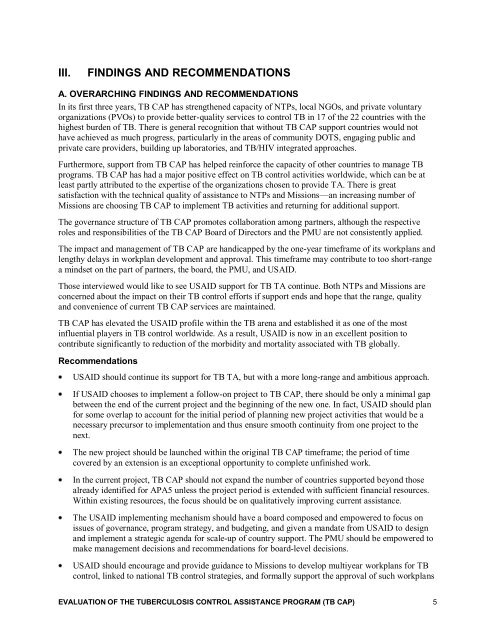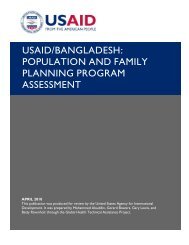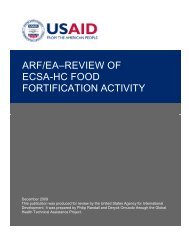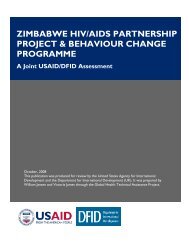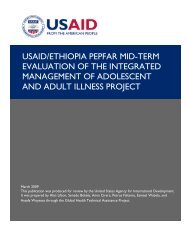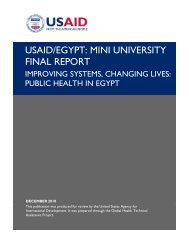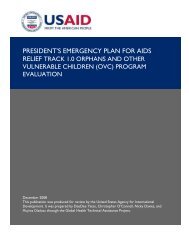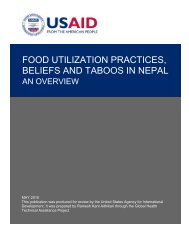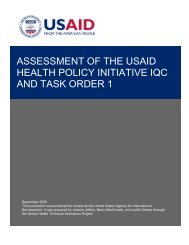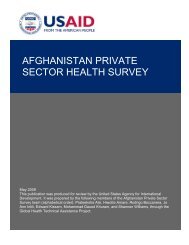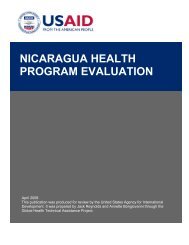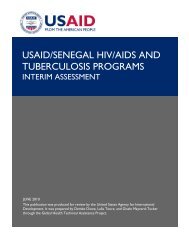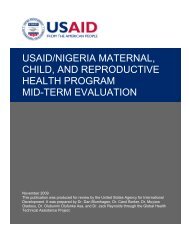Evaluation of the Tuberculosis Control Assistance Program (TB CAP)
Evaluation of the Tuberculosis Control Assistance Program (TB CAP)
Evaluation of the Tuberculosis Control Assistance Program (TB CAP)
You also want an ePaper? Increase the reach of your titles
YUMPU automatically turns print PDFs into web optimized ePapers that Google loves.
III.FINDINGS AND RECOMMENDATIONSA. OVERARCHING FINDINGS AND RECOMMENDATIONSIn its first three years, <strong>TB</strong> <strong>CAP</strong> has streng<strong>the</strong>ned capacity <strong>of</strong> NTPs, local NGOs, and private voluntaryorganizations (PVOs) to provide better-quality services to control <strong>TB</strong> in 17 <strong>of</strong> <strong>the</strong> 22 countries with <strong>the</strong>highest burden <strong>of</strong> <strong>TB</strong>. There is general recognition that without <strong>TB</strong> <strong>CAP</strong> support countries would nothave achieved as much progress, particularly in <strong>the</strong> areas <strong>of</strong> community DOTS, engaging public andprivate care providers, building up laboratories, and <strong>TB</strong>/HIV integrated approaches.Fur<strong>the</strong>rmore, support from <strong>TB</strong> <strong>CAP</strong> has helped reinforce <strong>the</strong> capacity <strong>of</strong> o<strong>the</strong>r countries to manage <strong>TB</strong>programs. <strong>TB</strong> <strong>CAP</strong> has had a major positive effect on <strong>TB</strong> control activities worldwide, which can be atleast partly attributed to <strong>the</strong> expertise <strong>of</strong> <strong>the</strong> organizations chosen to provide TA. There is greatsatisfaction with <strong>the</strong> technical quality <strong>of</strong> assistance to NTPs and Missions—an increasing number <strong>of</strong>Missions are choosing <strong>TB</strong> <strong>CAP</strong> to implement <strong>TB</strong> activities and returning for additional support.The governance structure <strong>of</strong> <strong>TB</strong> <strong>CAP</strong> promotes collaboration among partners, although <strong>the</strong> respectiveroles and responsibilities <strong>of</strong> <strong>the</strong> <strong>TB</strong> <strong>CAP</strong> Board <strong>of</strong> Directors and <strong>the</strong> PMU are not consistently applied.The impact and management <strong>of</strong> <strong>TB</strong> <strong>CAP</strong> are handicapped by <strong>the</strong> one-year timeframe <strong>of</strong> its workplans andlengthy delays in workplan development and approval. This timeframe may contribute to too short-rangea mindset on <strong>the</strong> part <strong>of</strong> partners, <strong>the</strong> board, <strong>the</strong> PMU, and USAID.Those interviewed would like to see USAID support for <strong>TB</strong> TA continue. Both NTPs and Missions areconcerned about <strong>the</strong> impact on <strong>the</strong>ir <strong>TB</strong> control efforts if support ends and hope that <strong>the</strong> range, qualityand convenience <strong>of</strong> current <strong>TB</strong> <strong>CAP</strong> services are maintained.<strong>TB</strong> <strong>CAP</strong> has elevated <strong>the</strong> USAID pr<strong>of</strong>ile within <strong>the</strong> <strong>TB</strong> arena and established it as one <strong>of</strong> <strong>the</strong> mostinfluential players in <strong>TB</strong> control worldwide. As a result, USAID is now in an excellent position tocontribute significantly to reduction <strong>of</strong> <strong>the</strong> morbidity and mortality associated with <strong>TB</strong> globally.RecommendationsUSAID should continue its support for <strong>TB</strong> TA, but with a more long-range and ambitious approach.If USAID chooses to implement a follow-on project to <strong>TB</strong> <strong>CAP</strong>, <strong>the</strong>re should be only a minimal gapbetween <strong>the</strong> end <strong>of</strong> <strong>the</strong> current project and <strong>the</strong> beginning <strong>of</strong> <strong>the</strong> new one. In fact, USAID should planfor some overlap to account for <strong>the</strong> initial period <strong>of</strong> planning new project activities that would be anecessary precursor to implementation and thus ensure smooth continuity from one project to <strong>the</strong>next.The new project should be launched within <strong>the</strong> original <strong>TB</strong> <strong>CAP</strong> timeframe; <strong>the</strong> period <strong>of</strong> timecovered by an extension is an exceptional opportunity to complete unfinished work.In <strong>the</strong> current project, <strong>TB</strong> <strong>CAP</strong> should not expand <strong>the</strong> number <strong>of</strong> countries supported beyond thosealready identified for APA5 unless <strong>the</strong> project period is extended with sufficient financial resources.Within existing resources, <strong>the</strong> focus should be on qualitatively improving current assistance.The USAID implementing mechanism should have a board composed and empowered to focus onissues <strong>of</strong> governance, program strategy, and budgeting, and given a mandate from USAID to designand implement a strategic agenda for scale-up <strong>of</strong> country support. The PMU should be empowered tomake management decisions and recommendations for board-level decisions.USAID should encourage and provide guidance to Missions to develop multiyear workplans for <strong>TB</strong>control, linked to national <strong>TB</strong> control strategies, and formally support <strong>the</strong> approval <strong>of</strong> such workplansEVALUATION OF THE TUBERCULOSIS CONTROL ASSISTANCE PROGRAM (<strong>TB</strong> <strong>CAP</strong>) 5


